You are reading this guide to learn more about the care for Sundew plants. I have cared for carnivorous plants for years, and this is what you need to know to see them thrive.
One of the most fascinating plants to the average public is carnivorous plants such as the sundew (Drosera) genera, with more than 194 species.
How To Care for Sundew Plants
To care for sundew plants, place them in soil that is acidic and low in nutrients such as sphagnum moss, perlite, or vermiculite. Sundew plants prefer bright indirect light with at least 6 hours of direct sunlight. The soil must be constantly moist and watered with filtered, reverse osmosis, rainwater, or distilled water. The temperature should be between 61-75°F (16-24°C). A humidity level of 40-60% is ideal. Fertilize using a diluted orchid fertilizer at 1/8 strength once a month.
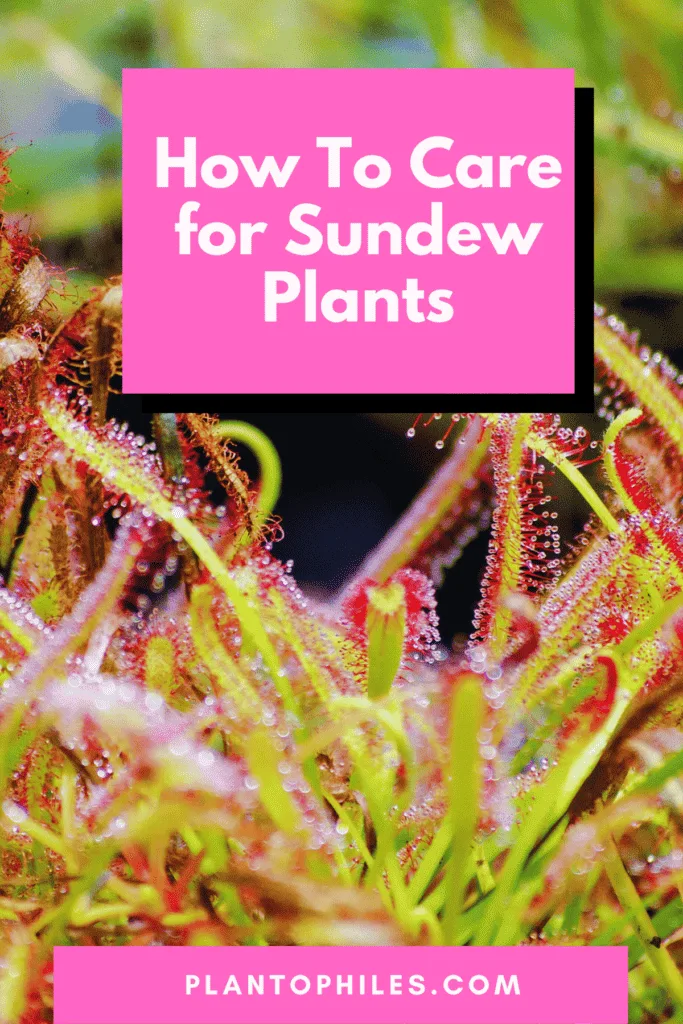
Drosera Takeaways
| Species | Drosera |
| Synonyms | Sundews |
| Family | Droseraceae |
| Genus | Drosera |
| Growth | Perennial, Carnivorous |
| Height | 6 feet |
| Width | 3.25 feet |
| Soil | Well-draining potting mix using peat, perlite, and sphagnum moss. No regular soil. |
| Watering | Water every 3-7 days |
| Light | Full sun |
| Temperature | Min: 60.0°F (15.6°C), Max: 80.0°F (26.7°C) |
| Humidity | Min: 50%, Max: 70% |
| Fertilizer | Once a month using diluted fertilizer |
| Propagation | Leaf cuttings, division, seeds |
| Toxicity | Non-toxic. However, do not touch and never ingest these plants. |
Table of Contents
Carnivorous plants
Plants are thought of as being beautiful, dainty, and harmless. Not these specimens!
Carnivorous plants use scents to lure prey to their leaf traps and use sticky fluids to imprison the insects, according to the University of Florida.
The University of York adds that these plants are flipping the relationship between plants and insects.
Usually, the insects are the ones that prey on the plants. Here, it is the other way around.
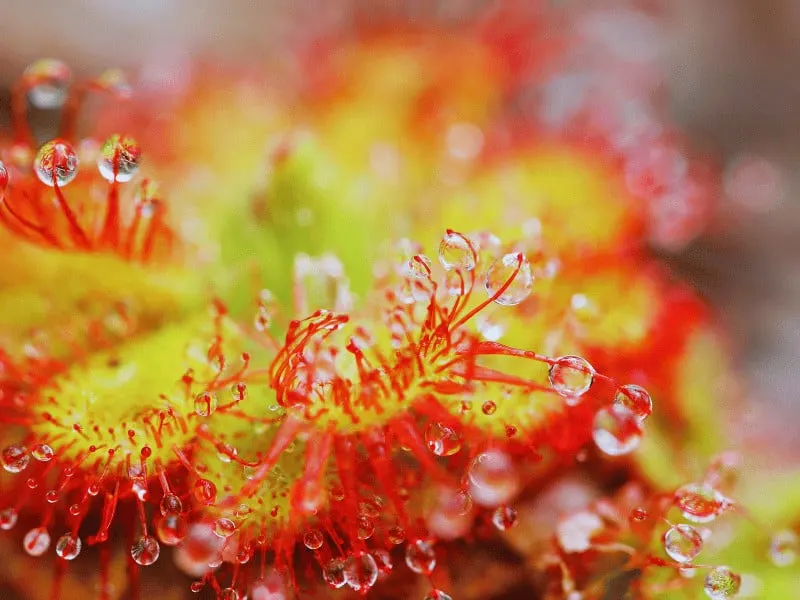
Sundew Plant Care
Members of the Droseraceae family are rather fun to keep in the confines of your home. You might assume they take more work than the typical houseplant, but that’s not necessarily true. There are a few differences, but with the proper research, you should be all set.
Soil
Provide sundew plants with potting mixes of sphagnum moss, perlite, and vermiculite.
Regular garden soil does not work for sundews. They rot and die. Their nitrogen levels usually are too high. Sundew plants prefer to grow in soil that is acidic and low in nutrients. The ideal pH level is 4-6.5.
The natural habitats of sundew plants are bogs, and marshes share these qualities.

Light
For most Drosera plants, full sun for at least 6 hours a day is ideal
In fact, carnivorous plants generally need lots of energy provided by direct sunlight or artificial ligt. It takes a lot for them to use their appendages to take in insects. The milky mucous lining is also quite taxing to produce.
Provide at least 4 hours of bright indirect light if direct sunlight is unavailable. There are a few exceptions to this rule.
The Queensland Sundew, for instance, needs low-level light.
If your house doesn’t have a lot of light, you might want to consider a different plant. We have an article about the best houseplants for low light.
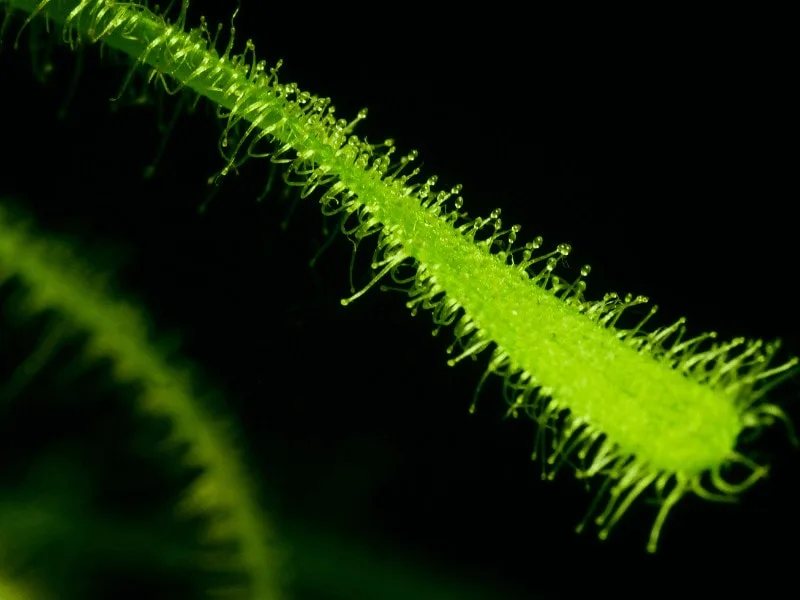
Watering a Sundew
Sundew plants need filtered, reverse osmosis, distilled, or rainwater.
Looking at where these plants live, it’s no surprise that they need the soil to stay consistently saturated.
There are a few techniques that work to combat this problem. The famous “tray method” is a great way to ensure the plant has enough water.
All you have to do is put your potted plant on a tray. As you water, the excess will run off onto the tray. This stops the Sundew from drying out.
They demand a near-constant trickle of water to reach their roots.
You can either keep watering them as if they were any other flora species. Or, you can opt for the tray method. This technique allows the pot to sit on a tray with the excess water.
Another noteworthy point to make about watering carnivorous plants is the type of water you use. Mineral-free water is the most ideal.
Some tap water contains over 50 parts per million impurities. This would likely cause havoc to your Drosera. Unless you have relatively pure tap water, use distilled water.
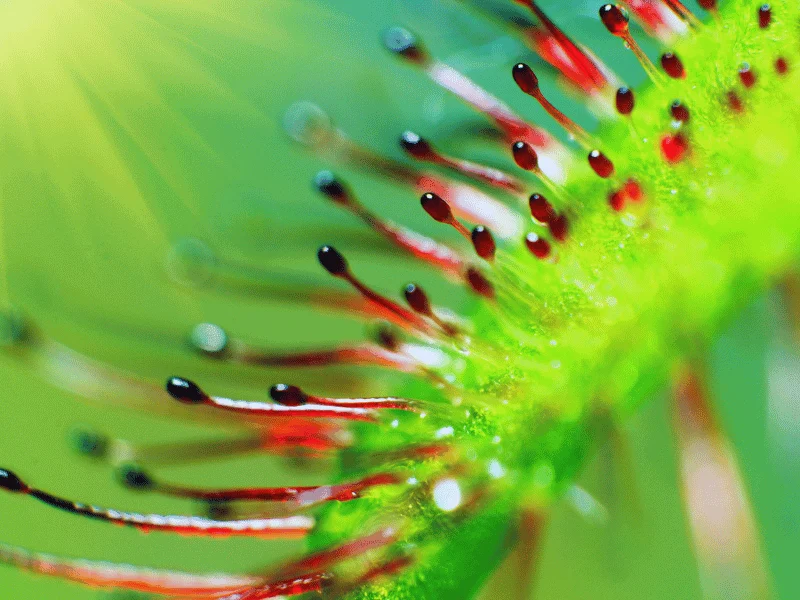
What is the Ideal Temperature for Sundews?
Sundew plants prefer a temperature between 61-75°F (16-24°C).
If your house is relatively warm, you might be advantaged.
Did you know these plants can go into a state of dormancy? This happens on both ends of the spectrum.
The winter months spark a dormancy where temperatures drop below 50°F degrees (10°C). Anything above 79°F (26°C) can produce the same results.
If this happens, don’t worry. Your Sundew is merely protecting itself.
This state can last up to a few months, in extreme changes.
Humidity
Indoor Sundew plants need an average humidity between 40 – 60% indoors.
Those who have ever experienced a bog or marshland will usually say there is a good amount of humidity. Carnivorous plants love lots of humidity.
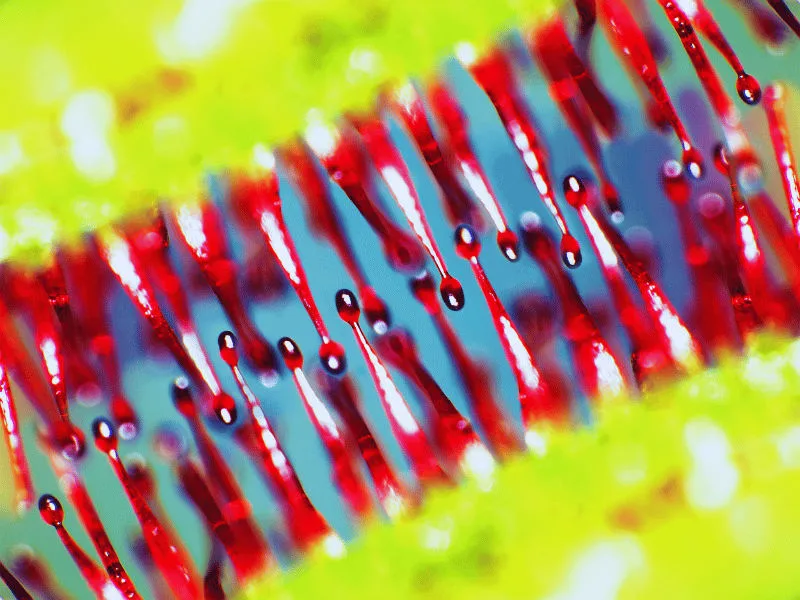
Sundew Plant Fertilization
Fertilize sundew plants with a diluted foliar fertilizer for orchids once a month or by providing a deathfly once a month.
Carnivorous plants are a bit tricky when it comes to fertilizer use. These plants already prefer a low-nutrient living space. By using fertilizers, you’re adding potentially toxic chemicals that can burn the leaves or worse.
When in doubt, don’t add it. There are mild all-purpose fertilizers, but even these should be diluted.
One of the main reasons why people add food to their Drosera individuals is to enhance the potential for pest capture.
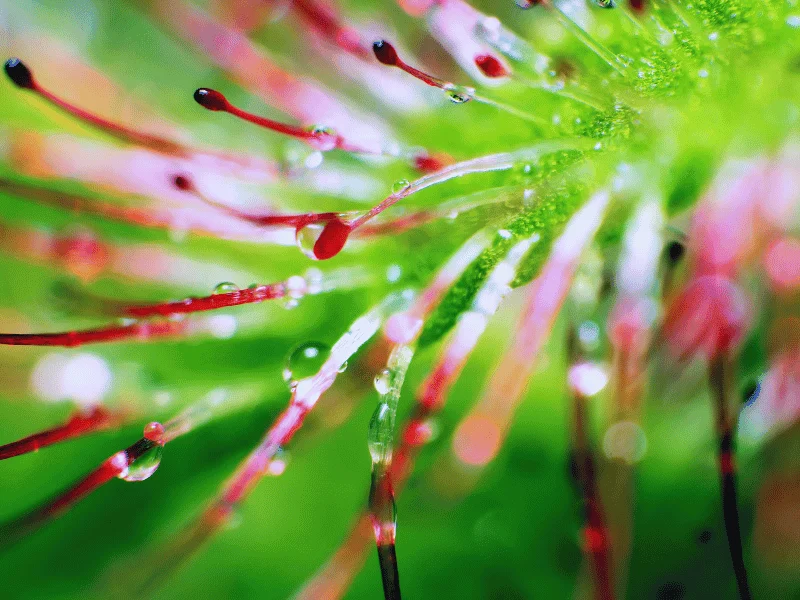
Sundew Propagation
Drosera is the largest genus belonging to carnivorous plants, with almost 200 different species.
Even within the subcategory of Sundews, there are almost 100 different types.
Although they share similar characteristics, there is enough of a difference that would change the propagation techniques. Generally, you can propagate your Sundew through leaf or flower stalk cuttings.
We will go over these in greater length later on in the article.
Growth
The biggest species you can own, the Giant Sundew, is only three feet tall.
The growth of a carnivorous plant depends greatly on how much food it receives. According to Missouri Botanical Gardens, Drosera will grow to 6″ tall in about a year and a half.
Other species of Sundews take a bit longer, sometimes even three years. There is also a great diversity in the size of a mature individual.
Potting
Larger sundew species need to be repotted every two years.
Most Sundew species can last a few years without the need to be repotted. Of course, this does change based on the specific species that you own.
After looking into data provided by carnivorous plant enthusiasts, the larger species take about two years to be repotted.
The smaller individuals tend to need it annually, perhaps because the roots grow quicker. You’ll want to go about this process at the warmer times of the year, preferably in the early stages of spring.
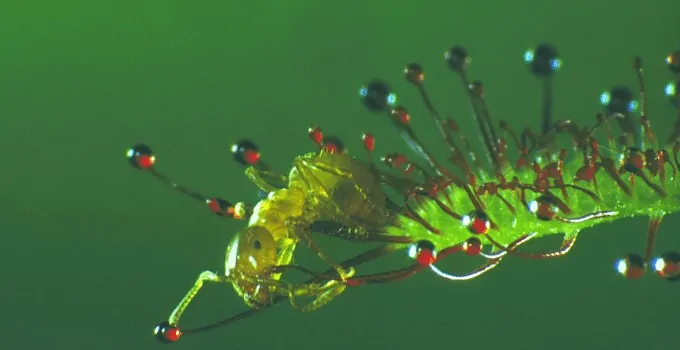
The Sundew Plant Analyzed
The Sundew plant is part of the largest genera of carnivorous plants called Drosera.
These individuals are known for their sticky tentacle-shaped appendages used to catch bugs accompanied by a mucous lining. Sundew is found nearly all over the world. But not in Antarctica.
They are typically found in moist places with plenty of sunlight, including swamps and marshes. Raising a Sundew plant indoors can be advantageous; you will have your bug killer.
Not only that, but sundew plants are also relatively easy to care for.
Sundew Plant Propagation Techniques
The easiest way to propagate a Sundew plant is to take leaf cuttings.
It’s been said that plant owners occasionally do this on accident, finding new sprouts forming in their plants.
So then, let’s look at how to copy your precious carnivorous plant through leaf cuttings.
Leaf Cuttings
- With a clean pair of scissors, make clean incisions on three or four leaves of your Sundew plant, each about four inches in length.
- Fill up a plastic tube with water and add a few leaf cuttings to the container, sealing it with a cap. The water used needs to be either pure tap water, or distilled.
- Watch over the next few months for signs that the leaves are sprouting. There will be sections that don’t make it. Remove these brown, dead cuttings.
Once there are roots that have started to form, you can place your leaf cutting into a small pot with fresh, saturated soil.
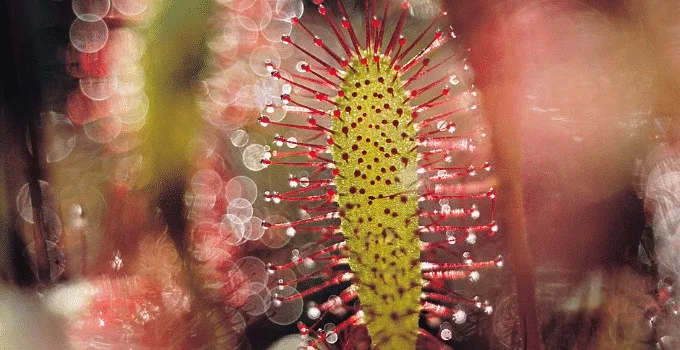
Drosera Pests
It might sound weird to say that insects can take down these bug-eating plants.
However, some pests can damage a carnivorous plant, such as the Sundew plant. Fortunately, they are all relatively easy to treat.
Several different types of pests will go after your Drosera.
For the insects, you can find aphids, mealy bugs, scale, spider mites, thrips, and moths. Powdery mildew can also appear in white spots along the plant.
Most pests can be dealt with through several rounds of insecticides and fungicides. Just be sure to research before attempting to rid your carnivorous plant of unwanted visitors.
My Sundew Plant is Struggling
Even if you’re experienced in raising plants, Drosera may be completely different. But don’t worry. We’ve got you covered. Here are some problems that you might find with your Sundew plant.
The Sundew is not Sticky
Cause: This might not sound like a problem, but carnivorous plants need their mucous lining to catch bugs.
If your Drosera lacks sticky properties, it usually tells you there isn’t enough humidity.
Remedy: Adding more humidity is a rather simple thing to do. You can lightly mist your Drosera, add a humidifier, or move it to a spot in the house with higher humidity levels.
Droopy Leaves on a Sundew Plant
Cause: The existence of leaves that droop is most likely an indicator that your plant needs more water.
Remedy: To increase the amount of moisture, increase your watering session. We also highly recommend using the tray method so your Sundew never dries out.
My Plant is Shifting to Black
Cause: As you might expect, a blackened individual is not a good sign. Heat stress is typically the reason for this happening.
Remedy: If you don’t catch this problem soon enough, your Sundew may die back to the roots. Simply move it to another room that isn’t quite as warm and allow it to return over the next few months.
Brown Leaves on a Sundew Plant
Cause: Although not as critical as black leaves, a brown shade isn’t all that great either. This color is generally because of water issues. Or the soil may be packed in too tightly.
Remedy: Try to see which problem you have first by adding more water than you would. Brown leaves can also be due to under-watering, so pay attention. If neither works, carefully remove the plant from its pot and transfer it.
5 Steps To Keep Your Sundew Thrivign
Carnivorous plants aren’t all that tricky regarding care as long as you keep these five points in mind!
- Start your plant off right with a soil mix designed for carnivorous plants!
- Supply at least four hours of full sun, depending on the species you own.
- Consider using the tray method to prevent the flora from drying out.
- If you’re concerned about humidity, mist your Drosera daily.
- Repot every few years to keep your Sundew happy!
FAQ
What do Sundew plants eat?
Sundew plants eat insects. You might not have known the process for these plants to get a proper meal. Once their prey is trapped, it takes about fifteen minutes and a few weeks to digest the insect fully.
Is the Sundew plant poisonous?
Yes, to a degree. Although Sundew plants aren’t technically poisonous, these plants contain something called “contraindications.” If you touch a carnivorous plant too often, you might experience irritation in the digestive tract.
Where can you buy a Sundew plant?
There are plenty of locations where you can buy your carnivorous plant. Plenty of garden centers have keyed into the appeal of these insect eaters. They are also sold online.
The Sticky Conclusion
Sundew plants cannot only help you to get rid of nasty flies and insects, but they are also easy to care for houseplants if you consider the specific care needs.

Daniel has been a plant enthusiast for over 20 years. He owns hundreds of houseplants and prepares for the chili growing seasons yearly with great anticipation. His favorite plants are plant species in the Araceae family, such as Monstera, Philodendron, and Anthurium. He also loves gardening and is growing hot peppers, tomatoes, and many more vegetables.


